Poha dosa is amazingly soft, spongy, porous crepes or pancakes made with flattened rice, idli rice, curd and urad dal batter. Poha is flattened rice and dosa are crepes. Poha has various names. So these dainty fluffy pancakes take the first name of this hero ingredient aka poha and are also called as Atukula Dosa or Aval Dosa or Avalakki Dosa in regional South Indian languages. Serve them with Coconut Chutney or Sambar for a comforting breakfast or lunch.
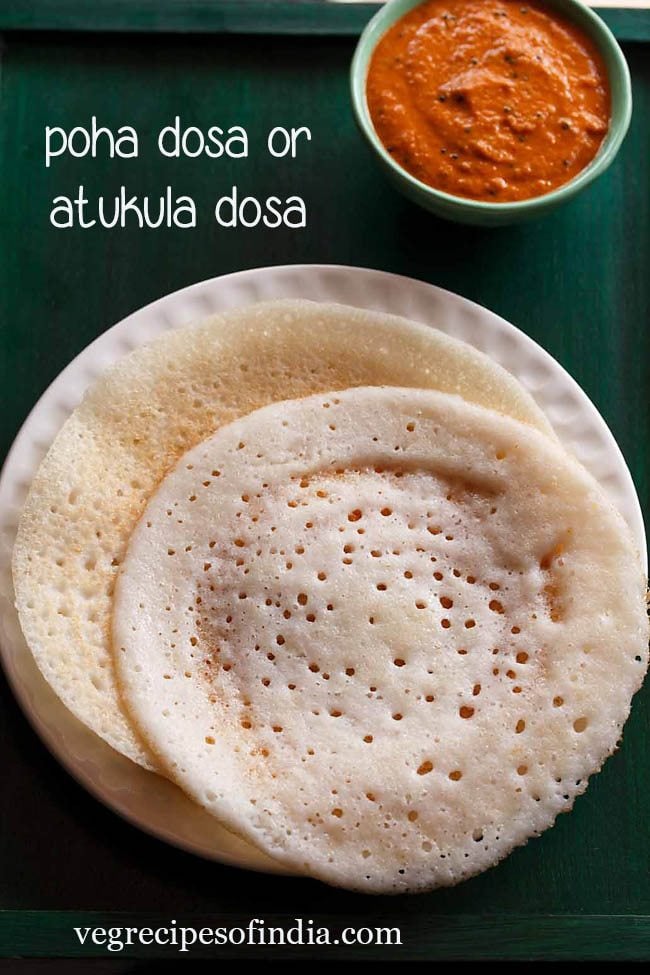
I chanced upon this atukula dosa decades back in Chandra Padmanabhan’s cookbook: “Simply South: Traditional Vegetarian Cooking”. Since then I have been making them often.
There are a few variations in making this recipe. What I share is an Andhra Style Poha dosa.
The method to make poha dosa is slightly different than the one for regular Dosa. Here the rice and poha are soaked in buttermilk. Then ground and fermented for 4 to 5 hours.
In fact, I like these dosas so much that I usually pair them with tea or coffee. When I made the dosas this time, I served poha dosa with red amaranth sambar and sesame coconut chutney.
These avalakki dosa remain soft even after some hours. Thus making them excellent for a tiffin box snack with a side of some dry powdered chutney like an Idli Podi. You can also pack for lunch or for short journeys.
While cooking them you can cook one side or both sides. They make for an excellent weekend or Sunday breakfast or brunch.
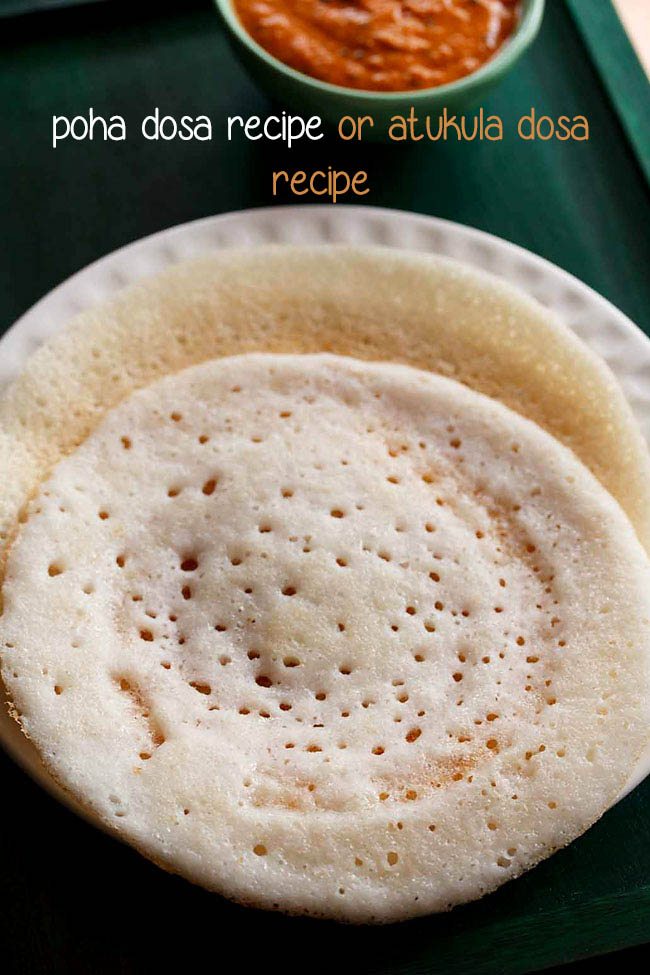
How to make Poha Dosa
Making Aval Dosa Batter
1. In a bowl, take ½ cup fresh curd (yogurt) and 1 cup water. Mix very well with a wired whisk to make buttermilk.
Don’t use sour curd as by the time the batter is fermented it will become very sour.
Alternatively you can use 1.5 cups of buttermilk.
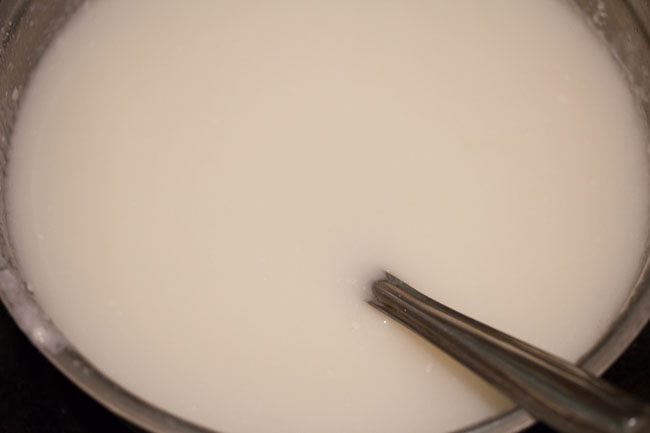
2. In a bowl, take 1 cup idli rice (parboiled rice) or regular rice like sona masuri or parmal rice.
Also add ½ cup thick poha (flattened rice) and 2 tablespoons urad dal (husked black gram).
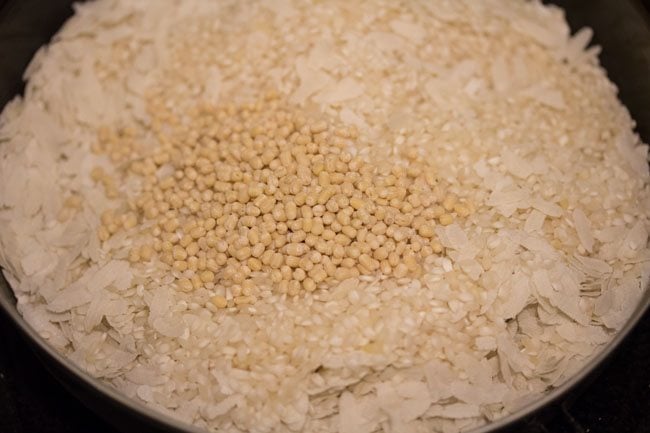
3. Rinse the rice, poha and urad dal a couple of times with fresh water. Then drain all the water.
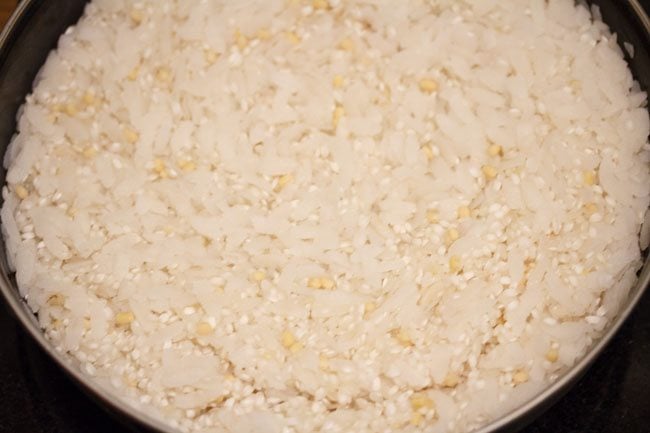
4. Now pour the prepared buttermilk (curd+water mixture) in the rinsed rice, poha and urad dal.
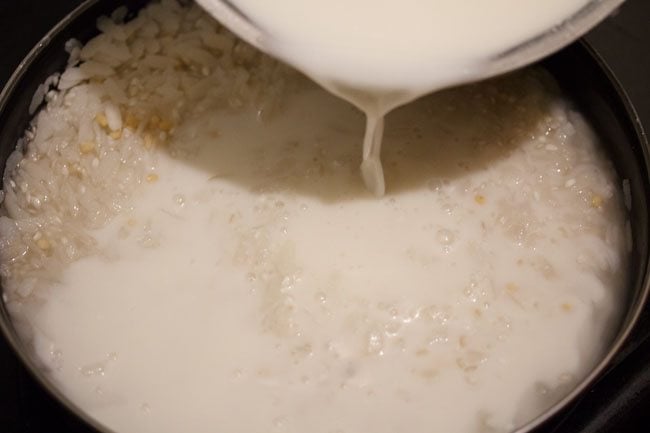
5. Gently stir the mixture.
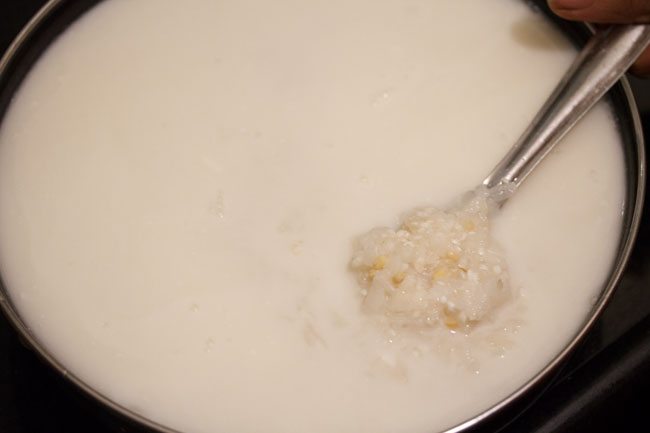
6. Soak the rice, poha and urad dal in the buttermilk mixture for 2 to 3 hours.
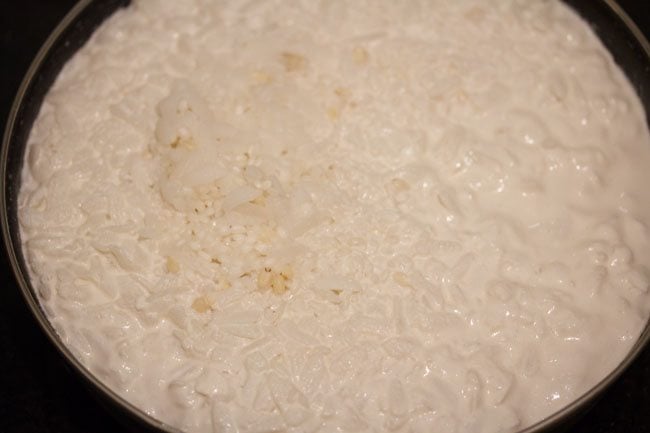
7. Drain and reserve the soaked liquid. Add the soaked rice, urad dal and poha to the blender jar.
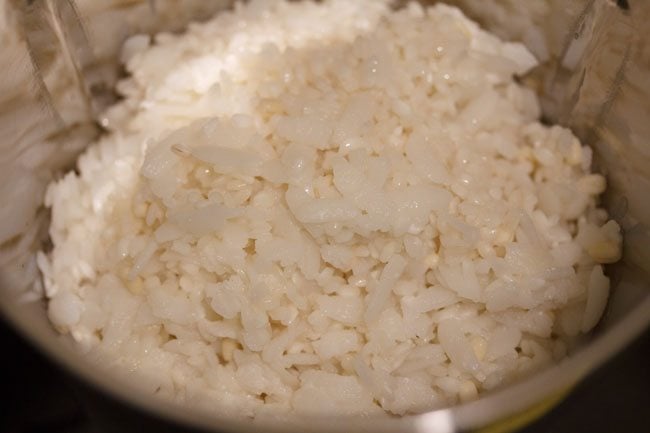
8. Grind or blend to a smooth batter using all of the reserved soaked liquid.
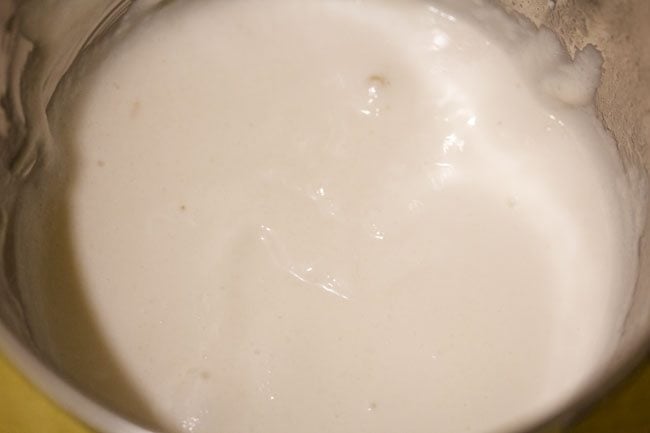
9. Remove the batter to a bowl and add ¼ teaspoon baking soda and 1 teaspoon salt.
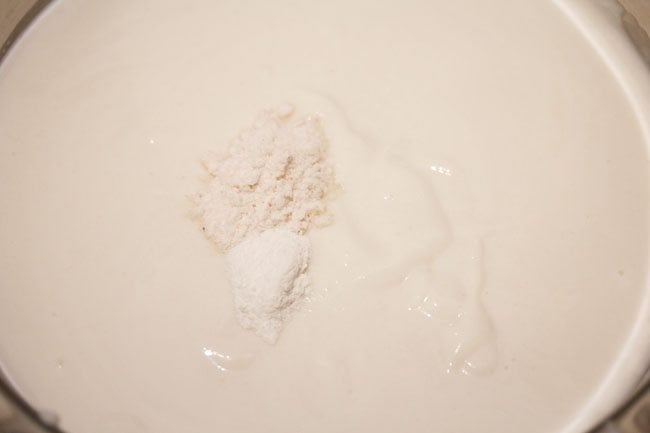
10. Mix well.
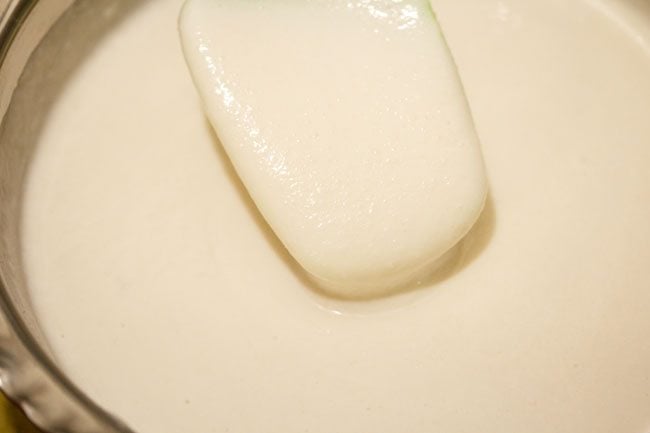
11. Ferment for 4 to 5 hours or as required. The batter should have a nice sour aroma.
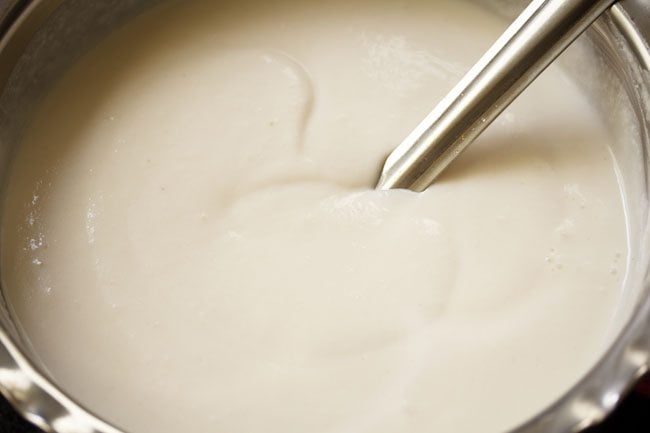
Cooking poha dosa
12. Heat a tava or griddle or a cast-iron skillet. Brush the pan with some oil. You can also spread the oil with an onion halve dipped in some oil or with a kitchen paper towel that has been folded and dipped in a bit of oil.
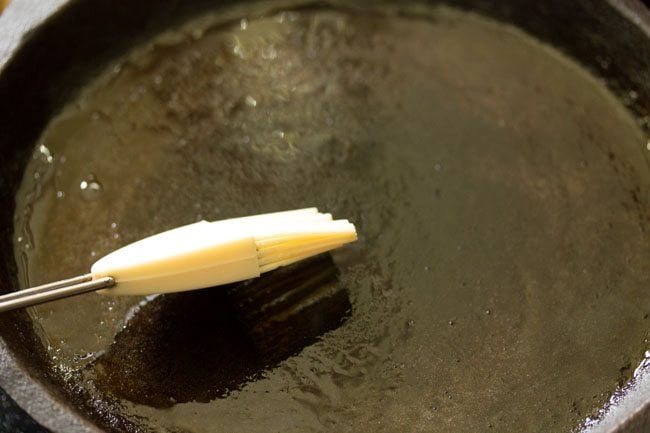
13. Take a ladle of batter and pour it on the pan. Keep the heat to low or medium-low so that you are able to spread the batter evenly.
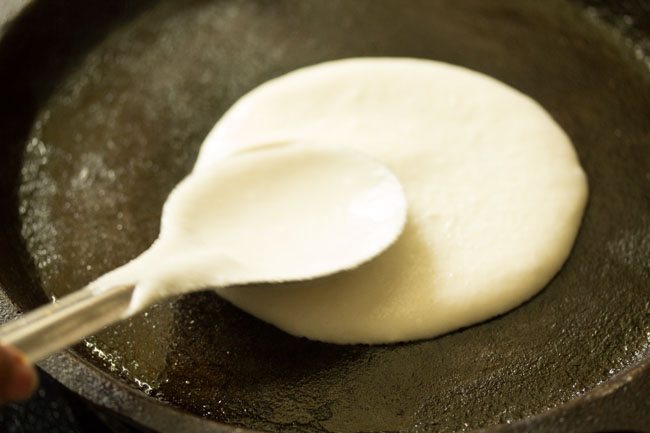
14. Starting from the center, spread the batter in a circular motion with the back of a spoon.
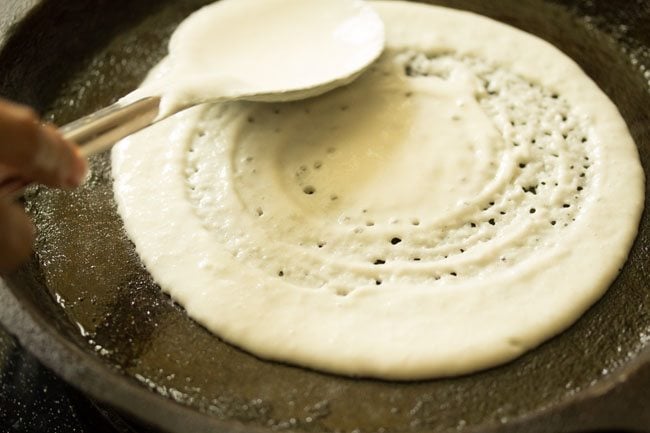
15. Make a slightly thick dosa and not thin like the regular dosa.
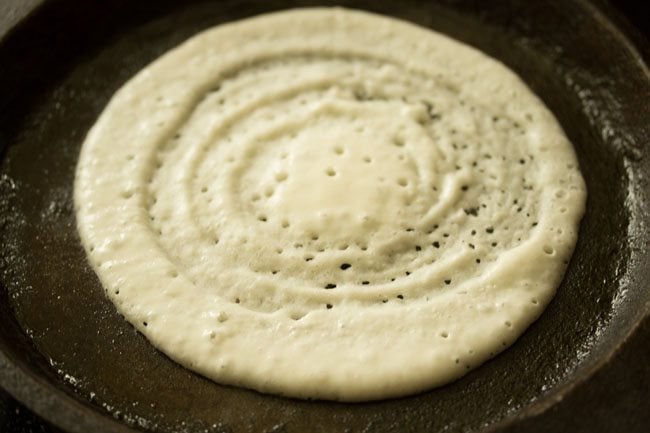
16. Drizzle oil around the edges and in the center.
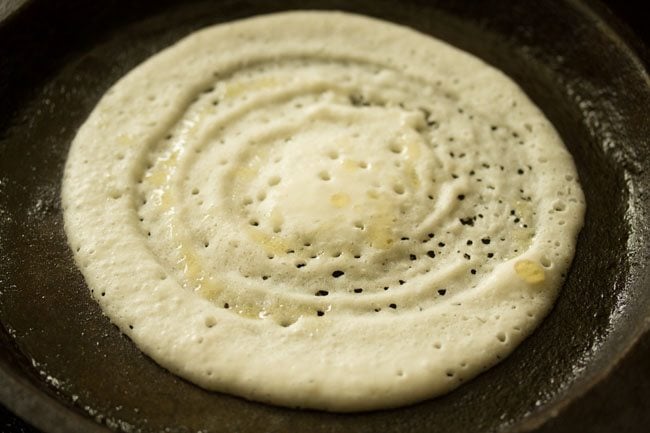
17. Cover the dosa with a lid.
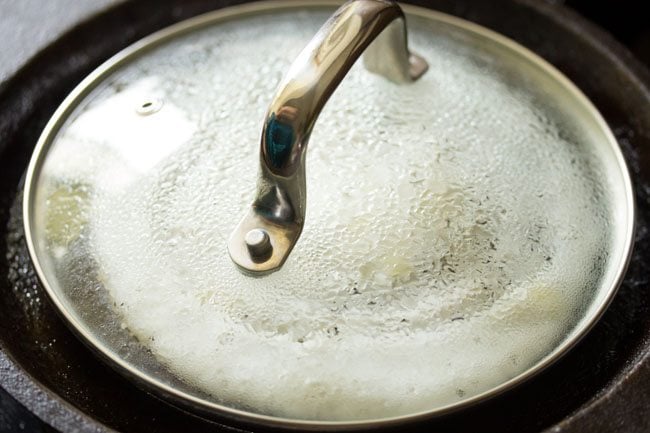
18. Cook them for 1 to 2 minutes or till the base is cooked and crisp and the top is soft and spongy.
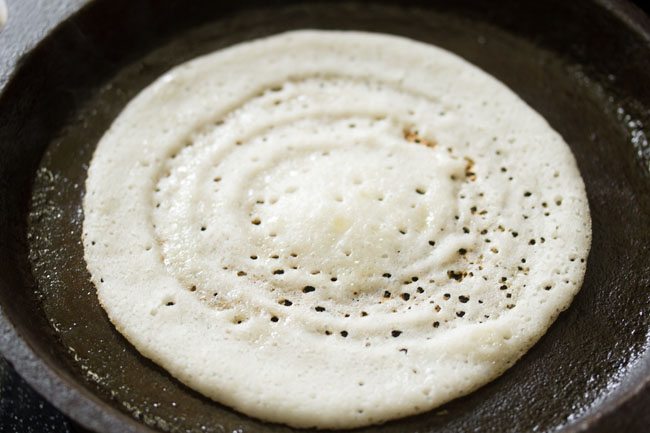
19. Flip the dosa and you can cook the other side if you want. Spread the oil which we had drizzle on top with a spoon.
You can choose to cook just one side or both sides of the dosa.
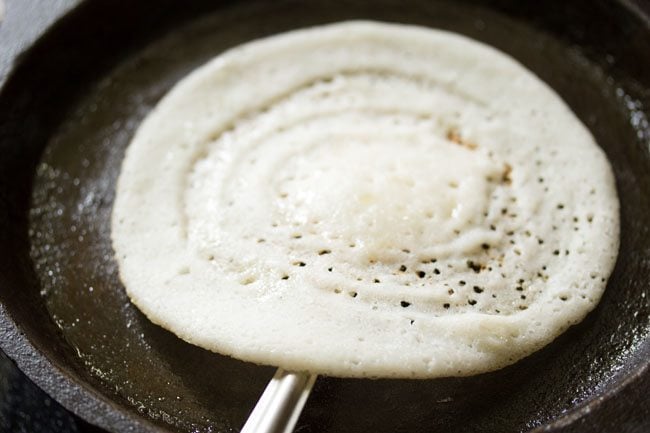
20. Similarly, make the rest of the dosa with the remaining batter. Refrigerate any leftover batter for 1 day. Don’t store the batter for more than 1 day as curd is used in the recipe.
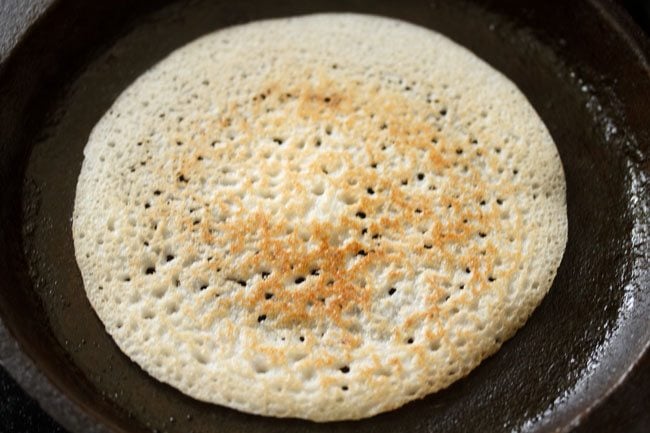
Serve Poha dosa hot or warm with coconut chutney or sambar. It can also be served with other chutney varieties like onion chutney, tomato chutney, peanut chutney, ginger chutney or idli podi.
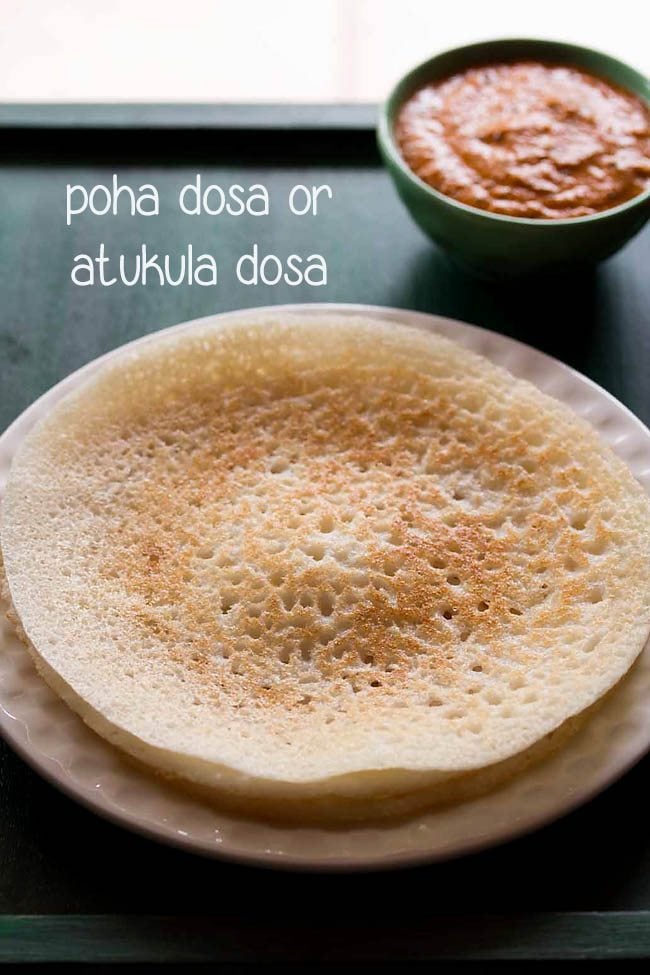
More tasty Dosa varieties:
Please be sure to rate the recipe in the recipe card or leave a comment below if you have made it. For more vegetarian inspirations, Sign Up for my emails or follow me on Instagram, Youtube, Facebook, Pinterest or Twitter.
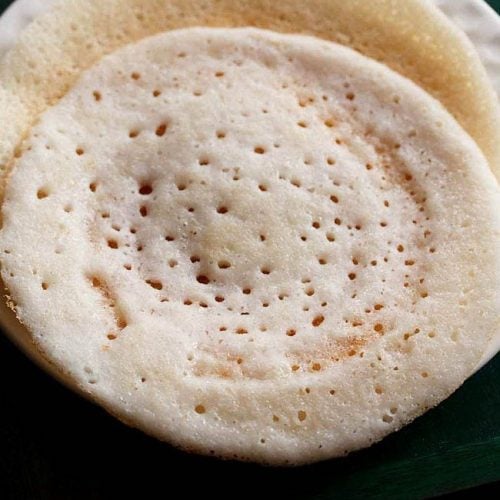
Poha Dosa | Atukula Dosa
Ingredients
- 1 cup idli rice or parboiled rice or regular rice like sona masuri rice, parmal rice – 200 grams
- ½ cup thick poha (flattened rice or parched rice) – 50 grams
- 2 tablespoons urad dal (husked black gram)
- ½ cup Curd
- 1 cup water for mixing with curd
- ¼ teaspoon baking soda
- 1 teaspoon salt or add as per taste
- oil as required
Instructions
Making aval dosa batter
- In a bowl, take fresh curd (dahi or yogurt) and water. Mix very well with a wired whisk to make buttermilk. Don't use sour curd.
- In an another bowl, take idli rice or parboiled rice or regular rice like sona masuri rice, parmal rice. Also add thick poha (flattened rice) and urad dal (husked black gram).
- Rinse the rice, poha and urad dal a couple of times with water. Then drain all the water.
- Now pour the prepared buttermilk (curd+water mixture) in the rinsed rice, poha and urad dal.
- Gently stir the mixture.
- Soak the rice, poha and urad dal in the buttermilk mixture for 2 to 3 hours.
- Drain and reserve the soaking liquid. Add the soaked rice, urad dal and poha in the blender jar.
- Grind or blend to a smooth batter using all of the reserved liquid.
- Remove the batter in a bowl and add baking soda and salt. Mix well.
- Ferment the batter for 4 to 5 hours or as required.
Cooking poha dosa
- Heat a tava or griddle or a cast iron pan. Brush the pan with some oil.
- Take a ladle of batter. Spread in a circular motion with the back of a spoon. Make a slightly thick dosa.
- Drizzle oil around the edges and on top of the dosa. Cover the dosa with a lid.
- Cook poha dosa for 1 to 2 minutes or till the base is cooked and crisp and the top is soft and spongy.
- Flip the dosa and you can cook the other side if you want.
- Similarly, make the rest of the avalakki dosa with the batter.
- Serve poha dosa hot with coconut chutney or sambar.
- Any leftover batter can be refrigerated for 1 day.
Nutrition Info (Approximate Values)
This Poha Dosa post from the blog archives first published in May 2012 has been republished and updated on 22 July 2021.












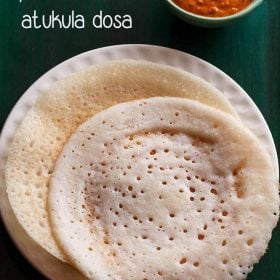
Hi Dassana,
My compliments for posting such a wide variety of recipes in such an engaging and reader friendly way. This website is my default for checking out new recipes, precisely for these reasons.
After going through the comments, I modified the dosa recipe by adding methi seeds and soaking overnight. I also added around 1 tbsp jaggery to the sesame chutney.
Turned out awesome! The combination is finger licking good! Thanks so much and keep up the good work!
hi hamsa, thank you very much. glad to know that you find the layout reader-friendly. generally, we get comments only the recipes and very rarely on the layout or presentation etc. so when feedback comes on the layout or presentation, it feels nice and good.
jaggery in sesame chutney is an awesome combination. i can gauge the flavors and taste. i should also try. thanks for sharing.
most welcome and happy cooking.
Thank you and my pleasure! In fact I really like how you weave in your personal experiences while sharing recipe facts. It makes the recipe so much more readable!
thank again hamsa. i try to add personal experiences but sometimes it is just not possible due to the complexity of the recipe. welcome and wish you all the best.
I have methi seeds and was going to add some to aid in the fermentation. How much should I add? Do I grind them with the rice after soaking?
Thanks!
you can add methi seeds. 12 to 15 methi seeds can be added. yes grind with rice after soaking. you can soak with either urad dal, rice and buttermilk mixture.
Tried this week. We as a family enjoyed the Poha Dosa!! Thank You
Welcome Mythili
Hi! Dasanna im lil bit confused . U have written fr fermentation u have to keep the batter fr 4 to 5 hours. But if i keep the batter overnight will the poha batter b more sour. Pls reply
asha, for poha dosa the batter can be kept for 4 to 5 hours. you can also keep overnight. if you keep the batter overnight it wont be sour. after 4 to 5 hours of fermentation, the batter does not have the typical sour aroma. since curd is added, there will be some sourness, but since the fermentation time is less, there will be some sweetness in the dosa. but if you keep for overnight, the batter does not become sour. also fermentation depends on the temperature. since winters are going on, you can keep the batter overnight or for some more hours.
Hi ,I have a doubt …we must need to use baking soda or we can skip it…bcoz I don’t want to use baking soda…
If I will not use soda ,the dosa will come perfectly… Plzz give fast reply…I am waiting…
baking soda makes the dosa more softer and porous. if you want you can skip also.
Thank you for sharing a healthy and tasty recipe,i will try it out.
Welcome Emon
Can we omit the buttermilk and use just water…… as my son is allergic to milk and curd
Sirisha, yes you can do this way. but for some sourness, you can add 1 tablespoon lemon juice to the poha dosa batter.
Suppose to use curd or buttermilk..???
In ingredients section its mentioned fresh curd; while recipe method its buttermilk that is being mention..!!!
Bit Confuse.. waiting for your reply to try this one (recipe)
i have used curd. i have mixed the curd with water and hence called it as buttermilk in the post. just mix the curd with water and then soak the rice, poha and urad dal in it. rinse all the ingredients before soaking.
It was a nice and great recipe
Hi friend ? Am visiting ur blog for first time. Moment I saw ur recipie for poha dosa I tried it. Have a doubt friend. Hope yo will clarify it. I fermented the batter for 6 hours but I dnt find the batter puffing up as normal dosa do. Did I go wrong somewhere? Please lemme know what should I do and how many days can I use the batter?
this batter does not ferment and double like the normal dosa. you have not gone wrong anywhere. you can keep the batter in the fridge for 2 to 3 day and use it whenever required.
Thanks for your reply ☺️☺️☺️ But I guessed since my place is too cold it’s not fermenting and kept it outside for more than 12 hours. I dnt refrigerate it. Can I use now ????? Keeping the batter outside for long time causes any health issues???
okay. keep in the fridge. do check how the batter smells. it should have a faint sour aroma. if it smells bad than you will have to discard it.
First, thank you so much for your excellent and beautiful website. I love it!!! Your recipes are delicious and I use them often.
When making this poha upma, what grade of poha do you recommend? I found thick, thin, medium and others at my store and wasn’t sure which to choose. Would you give us an education on poha?
Many thanks again. You are a treasure.
thanks a lot janis. its thick poha. i will also update in the recipe. you can also use medium poha but don’t use thin poha. may be i should write a post on different types of poha 🙂
Hi, thanks for the wonderful receipes, i have a doubt, for poha dosa we need to use sour curd? Only 4-5hrs fermentation is required? Plez …..
you can use fresh curd also. yes this much time is enough.
Hi dasana, after a short gap, am writing to u…. Exam time…bit busy…
Would like to share the way I make this type of dosa… Rice n poha 1:3 soak 4 to 5 hrs n add 1/4 part sabudana or tapioca… No curd or buttermilk… Cumin n fenugreek seeds a few… Grind ferment overnight…
In cold weather it takes more time to ferment, in summers… No problem wt fermentation… As urad dal is not added. Soft spongy texture can be got by cooking on low flame n covering dosa with a plate..
Loved malpua recipe… Bye
all the best sneha for your exams. what is this dosa called. i have noted down the ingredients and will give a try.
Hi dasana, it is the same dosa, call it poha,or soft or set dosa. We at bangalore call it medu dosa….medu in kannada is soft. some times to fasten the process of fermentation, we add curd while grinding. Sabudana n poha together render the softness……by the way, my children r writing exams…so busy me, but then I do check the new entries to ur blog everyday.
Bye.
thanks sneha for sharing the info. i have had set dosa many times. but never heard of medu dosa. take your own time. exams are more important 🙂
Hi dassana
I soaked the rice, poha in the buttermilk (2cups) I. E. 1cup=250ml. After 1.5hr, poha absorb the buttermilk .so, I added the water in it to soak few more hours. Please help me out. I have done any mistake by adding water. Thanks a lot.
poha will absorb the buttermilk. but still there will be some buttermilk. there was no need to add any water. now what you do is strain the mixture. reserve the excess buttermilk. while grinding, add the buttermilk as required.
As i am one of the frequent visitors of your website, i definitely will try it in my kitchen. Thank u. keep posting variety Andhra yummy dishes. In all my rice related dishes, i generally use unpolished rice for keeping up the levels of B complex in food.
thanks jhansi for the feedback. even i use unpolished rice for dal and sambar and veggie dishes. only while making biryanis and pulaos, i use basmati rice.